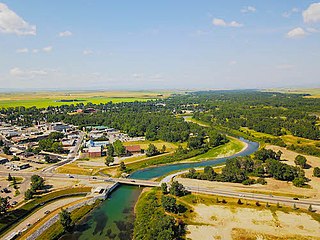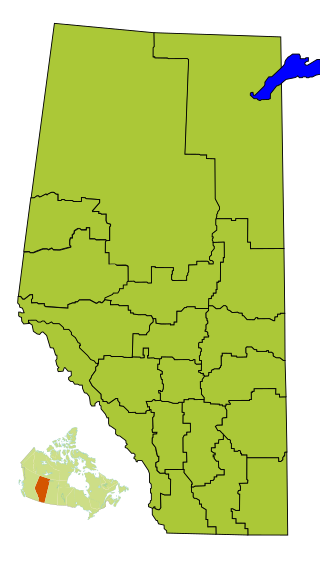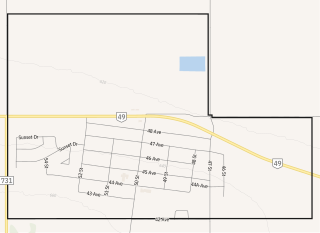Bassano is a town in Alberta, Canada. It is located on the Trans-Canada Highway approximately 140 kilometres (87 mi) southeast of Calgary and 160 kilometres (99 mi) northwest of Medicine Hat. It is also on the main line of the Canadian Pacific Kansas City. A short distance south of the town is the Bassano Dam, serves as a diversion structure which routes water through a canal into Lake Newell Reservoir which supplies water to the majority of the County of Newell for purposes like irrigation, recreation, and the County's drinking water.
Penhold is a town in central Alberta, Canada. Penhold is surrounded by Red Deer County, 16 km (9.9 mi) south of Red Deer at the junction of Highway 2A and Highway 42. It is located 128 kilometres (80 mi) north of Calgary, east of the Red Deer River.

Fairview is a town in Peace Country, Alberta, Canada. It is located 82 km (51 mi) southwest of Peace River and 115 km (71 mi) north of Grande Prairie at the intersection of Highway 2 and Highway 64A.

Stettler is a town in east-central Alberta, Canada that is surrounded by the County of Stettler No. 6. The town is nicknamed "The Heart of Alberta".

Stony Plain is a town in the Edmonton Metropolitan Region of Alberta, Canada that is surrounded by Parkland County. It is west of Edmonton adjacent to the City of Spruce Grove and sits on Treaty 6 land.
Coronation is a town in east-central Alberta, Canada that is surrounded by the County of Paintearth No. 18. It is located at the intersection of Highway 12 and Highway 872, approximately 100 kilometres (62 mi) west of the Saskatchewan border.
Bowden is a town in central Alberta, Canada. It is located in Red Deer County on the Queen Elizabeth II Highway, approximately 45 km (28 mi) south of Red Deer.

Olds is a town in central Alberta, Canada within Mountain View County and the Calgary–Edmonton Corridor. It is approximately 61 km (38 mi) south of Red Deer and 90 km (56 mi) north of Calgary. The nearest towns are Didsbury to the south, Bowden to the north, Sundre to the west and Three Hills to the east. Olds is located at the intersection of Highway 27 and Highway 2A, 5 km (3.1 mi) west of the Queen Elizabeth II Highway. The Canadian Pacific Kansas City's main Edmonton-Calgary line runs through the town.

Didsbury is a town in central Alberta, Canada at the foothills of the Rocky Mountains. It is located next to Alberta Highway 2A, near the Queen Elizabeth II Highway. Didsbury is within the Calgary-Edmonton corridor. Didsbury is approximately the half-way point between the cities of Calgary and Red Deer.

Beaumont is a city in Leduc County within the Edmonton Metropolitan Region of Alberta, Canada. It is located at the intersection of Highway 625 and Highway 814, adjacent to the City of Edmonton and 6.0 kilometres (3.7 mi) northeast of the City of Leduc. The Nisku Industrial Park and the Edmonton International Airport are located 4.0 kilometres (2.5 mi) to the west and 8.0 kilometres (5.0 mi) to the southwest respectively.

High River is a town within the Calgary Metropolitan Region of Alberta, Canada. It is approximately 68 kilometres (42 mi) south of Calgary, at the junction of Alberta Highways 2 and 23. High River had a population of 14,324 in 2021.

Vauxhall is a town in southern Alberta, Canada that is surrounded by the Municipal District of Taber. It is on Highway 36 approximately 36 km (22 mi) north of Taber, 69 km (43 mi) south of Brooks and 114 km (71 mi) west of Medicine Hat. It is situated in the prairie land between Bow River and Oldman River.

Division No. 8 is a census division in Alberta, Canada. It is located in the south-central portion of central Alberta and includes the City of Red Deer and surrounding areas. The division forms the central segment of the Calgary–Edmonton Corridor. Division No. 8 is the smallest census division in Alberta according to area.

Beaverlodge is a town in northern Alberta, Canada. It is located on Highway 43, 43 km (27 mi) west of Grande Prairie and 48 km (30 mi) east of the British Columbia border.
Blackfalds is a town in central Alberta, Canada. It is located along Highway 2A 13.5 km north of Red Deer. The town's name, Waghorn, changed in 1903 to Blackfalds, after Blackfalds, a Scottish hamlet.

Grande Cache is a hamlet in West-Central Alberta, Canada within and administered by the Municipal District of Greenview No. 16. It is located on Highway 40 approximately 145 kilometres (90 mi) northwest of Hinton and 435 kilometres (270 mi) west of Edmonton. Grande Cache overlooks the Smoky River, is at the northern edge of Alberta's Rockies, and serves as a gateway to the Willmore Wilderness Park. The hamlet held town status prior to 2019.

McLennan is a town in northern Alberta, Canada. It is approximately 50 km (31 mi) north of High Prairie on Highway 2.

Rainbow Lake is a town in northwest Alberta, Canada. It is west of High Level at the end of Highway 58, in Mackenzie County.
Sedgewick is a town in central Alberta, Canada. It is approximately 83 km (52 mi) east of Camrose at the junction of Highway 13 and Highway 869. The Canadian Pacific Kansas City railway runs through the town.

Spirit River is a town in northern Alberta, Canada. It is approximately 78 km (48 mi) north of Grande Prairie at the junction of Highway 49 and Highway 731.















